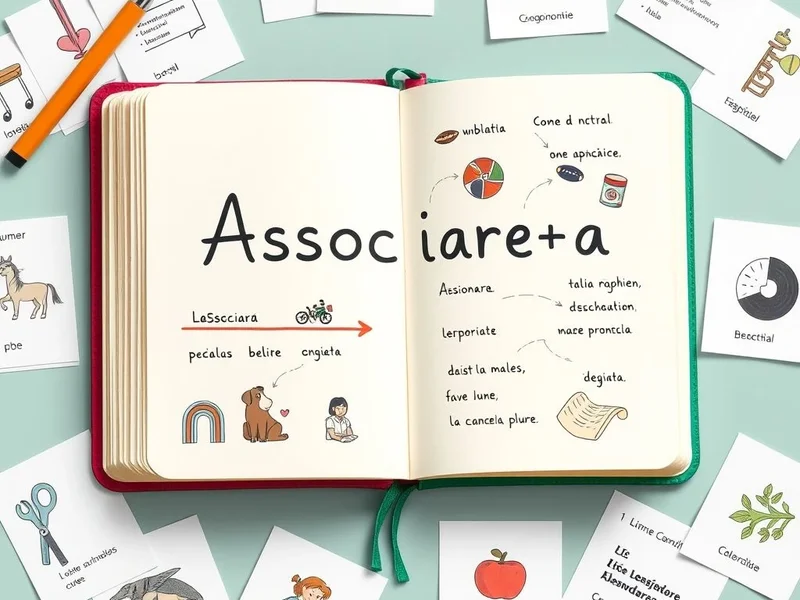How to Use "Associare a": Meaning and Practical Examples
When learning Italian, encountering expressions like "Associare a" can be a bit confusing. This phrasal verb is essential for enriching your practical Italian vocabulary and communicating more naturally. Many students wonder whether to use "Associare a," "con," or other prepositions. Don’t worry! In this article, we’ll explore the precise meaning of "Associare a," its grammatical structure, provide you with clear examples, and discuss the most common mistakes to avoid, helping you use it correctly and with confidence in your spoken Italian. Get ready to master this useful expression!

Table of Contents
- What does “Associare a” mean?
- The Grammatical Structure: How is it Used?
- Sentences and Examples with “Associare a”
- Crucial Differences: Common Mistakes to Avoid
- Similar or Related Expressions
- Conclusion
More: How to Use Assistere a for Meaning, Structure, and Examples
What does “Associare a” mean?
- Literal Meaning: To link, to join, to physically connect something to something else.
- Example: "Ha associato il cavo del caricatore al telefono."
- Figurative Meaning: To relate mentally, to connect an idea, a person, or a concept to another.
- Example: "Associo sempre il profumo del caffè alla nonna."
More: How to Use Aspirare a for Speaking Authentic Italian
The Grammatical Structure: How is it Used?
The basic structure to use this expression is simple:
[Subject] + associare + [Something/Someone] + a + [Something/Someone]
The verb is transitive, which means it requires a direct object (the thing being associated). The preposition "a" is essential and introduces the element or person to which the link or association is created, specifying the direction of the connection. It conjugates regularly as a first conjugation verb (-are), so its forms will depend on the tense and mood. According to Treccani, "associare" means "to unite, to join in various ways two or more things or people." This confirms the importance of the link being established.
More: How to Use Arrivare a Meaning and Practical Examples
Sentences and Examples with “Associare a”
Here are some practical examples to understand how "Associare a" fits into natural speech:
📍 Work / Team Building
Person A: "Dobbiamo associare questo nuovo progetto a un obiettivo di sostenibilità."
Person B: "Ottima idea, così daremo più valore al nostro impegno."
📍 Culture / Memories
Person A: "Non riesco a non associare questa canzone all'estate del 2005."
Person B: "Anche io! Mi ricorda un periodo spensierato."
📍 Marketing / Image
Person A: "La nostra campagna mira ad associare il marchio a un'immagine di innovazione."
Person B: "Credo che sia la strategia giusta per attirare nuovi clienti."
📍 Cooking / Pairings
Person A: "Che vino consiglieresti da associare a questo piatto di pesce?"
Person B: "Direi un Vermentino, si sposa perfettamente."
Crucial Differences: Common Mistakes to Avoid
A common mistake in using the verb concerns the choice of preposition. Often, you might be tempted to use "con" instead of "a," but there is an important distinction.
- Associare a (transitive) Vs. Associare con (incorrect in this context)
"Associare a" indicates a direct connection or attribution of something to something else. The preposition "a" is crucial because it signals the destination, the end-point of the association. Using "con" would imply the idea of "together with," of accompaniment, which does not correspond to the sense of creating a mental or conceptual link toward something.
- Correct Example: "Associo la calma al suono delle onde." (I connect calm to the sound of the waves.)
- Incorrect Example: "Associo la calma con il suono delle onde." (This sounds as though calm and the sound of the waves are associated together, not that calm is linked to the sound as its origin or the destination of the association.)
It is also important to distinguish the transitive verb from its reflexive form "associarsi." This grammatical difference completely changes the meaning of the action.
- Associare a (transitive): To link one thing to another, to attribute a quality or concept. The subject performs the action on an object.
- Example: "Associo il colore verde alla natura." (I link green to nature.)
- Associarsi a (reflexive): To join a group, organization, or to take part in a shared activity. The subject performs the action on themselves, becoming part of something.
- Example: "Ho deciso di associarmi a un club di lettura per incontrare nuove persone." (I join a club.)
Similar or Related Expressions
To further enrich your Italian vocabulary and communication ability, here are some expressions with meanings similar or related to "associare a":
| Similar Expression | Brief Meaning | Example |
|---|---|---|
| Collegare a | To unite, to create a link | "Collego questo evento a un ricordo lontano." |
| Abbinare a | To combine for harmony or purpose | "Abbinare un vino rosso alla carne." |
| Ricollegare a | To find a connection, to recall | "Ricollego la sua idea a un vecchio progetto." |
| Connettere a | To establish a technical connection | "Connettere il telefono al Wi-Fi." |
Conclusion
We have explored "associare a" in depth, an extremely useful Italian expression for expressing both physical and mental connections. We have learned that its strength lies in the use of the preposition "a," which directs the connection toward a specific idea or element. Knowing this grammatical rule will help you communicate more precisely and naturally. Now it's your turn to put what you've learned into practice! Think of an experience, an object, or an emotion: what or who do you associate it with? Share your sentence using "associare a" in the comments below. We love to see how you use new expressions!